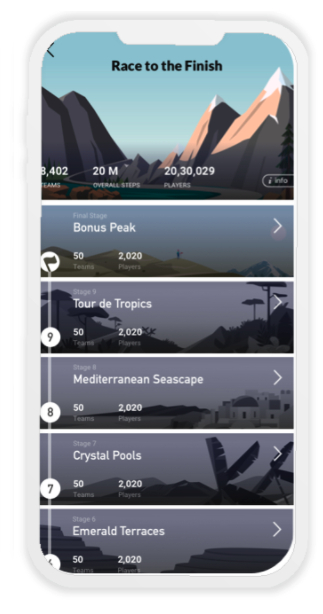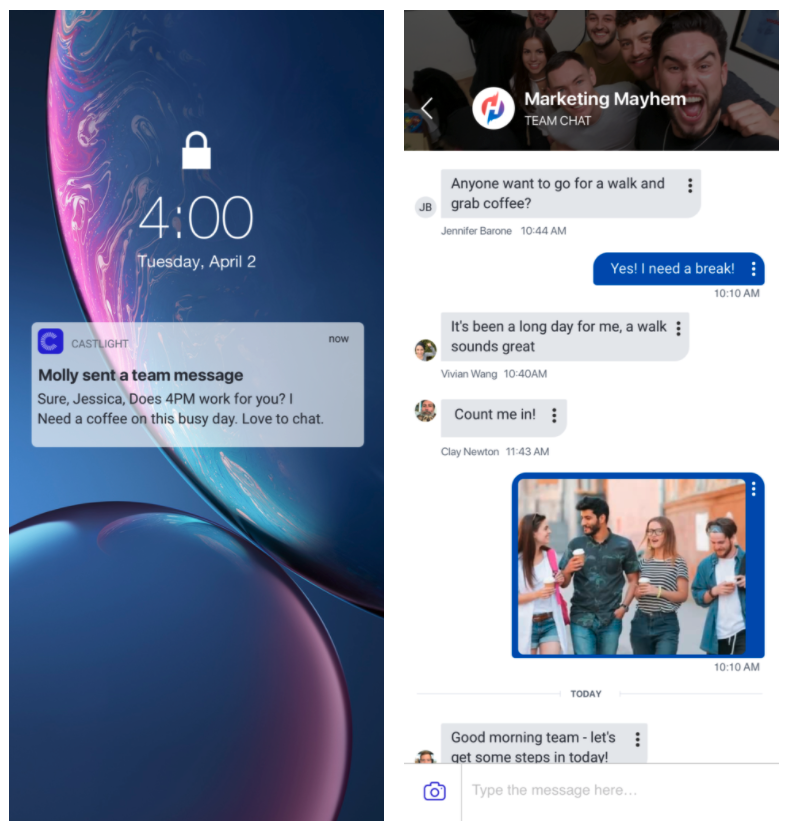Steps challenges—activities that leverage healthy competition and encourage physical movement—are widely used by employers to boost camaraderie and get employees active. It’s no surprise that company-wide challenges are so commonly used in health benefits strategies, as they’re an effective, reliable, and surprisingly easy tool to implement and use.

At Castlight, challenge setup is simple—all customers have to do is select a start date and choose whether or not to award points (within the app) and/or prizes.
Customers who leverage Castlight’s challenge feature see impressive results. During challenge periods, they experience up to a 7% increase in benefits program registration. In addition, challenge participants gain a daily average of 1,480 more steps, have 2x more sustained app usage and 1.5x more program utilization, and 75% of participants are active on a weekly basis.
The increase in steps—which is fantastic in itself—is the gateway to an even greater advantage: getting employees to engage in their health and wellbeing more and driving them to utilize programs and benefits made available to them by their employer. Ultimately, participating in a challenge helps employees live their healthiest lives in a multitude of ways.
Why Are Challenges So Effective?
Challenges produce results because they’re developed based on science-backed behavior change models and use game mechanics to create a fun, engaging experience.
Behavior change research dates back nearly a century to Kurt Lewin, the father of social psychology. Modern day behavioral scientist BJ Fogg nicely summarizes many of the field’s findings into a model highlighting three things that are needed to change people’s actions: motivation, ability, and prompt.
Motivation means that people will move toward experiences that contribute positively to pleasure, hope, and social acceptance. And they will move away from experiences that cause pain, fear, or a sense of rejection. Ability refers to making actions simple and attainable, ensuring a person is capable of completing a target behavior. Prompt means giving people a cue to act now, such as a push notification reminding participants to record their steps. When all three of these factors are present, behavior change can occur.
With all of the available research on behavior change, Castlight concluded that challenges should be pleasurable and include a social connection component (motivation), easy to achieve (ability), and have a clear call to action (prompt). This can transform an employee’s experience by turning what seems like a daunting task—being more physically active—into a fun activity, better enabling individuals to create healthy habits.
How to Get the Most out of Challenges
Castlight has a few main recommendations to help companies get the most mileage from their challenges.
- Timing: There’s no wrong time for a challenge. We recommend hosting a challenge twice a year, as this frequency allows companies to reap even more benefits—more registration, more activity, more program utilization—without creating challenge fatigue from hosting too many during the year. And while there’s no wrong time, it’s wise to make sure these activities don’t overlap with big company-wide events, like open enrollment, so company communications can focus on the challenge.
- Rewards and Incentives: These can be a great way to motivate employees to participate. If your wellbeing rewards are based on a points system, you could encourage challenge enrollment and daily engagement by offering five points for completing specific actions. Earning a sweepstakes entry (to win bigger prizes like a $100 gift card) for achievements such as signing up for the challenge, joining a team, and achieving challenge milestones promotes continued participation, even if the individual isn’t on a top team. And, an additional reward for the top teams or individuals at the end of the challenge can make it seem more fun by peppering in a bit of healthy competition. Some Castlight customers even commit to making a company donation to a charity if their employees can meet an organization-wide step goal.
- Challenge Type: Much like how there’s no wrong time, there’s also no wrong type of challenge to choose as long as each one promotes social connection and motivation, whether through a team chat (Castlight’s team challenge chats are quite active!), tagging colleagues, or sharing gifts during a challenge. However, it is a good idea to offer different types of challenges to keep things fresh and exciting for members. Castlight’s philosophy is to alternate between various challenge offerings.
- Promotion and Prompts: Employers who actively promote the challenge can see higher engagement from employees. For example, Castlight provides customers with a suite of marketing collateral, such as posters, employee emails, and communications templates for the employer’s intranet and other channels. In addition to reminders from the employer, Castlight also stimulates challenge engagement by sending notifications that celebrate achievements and promote social connection.

In summary, challenges encourage more physical activity, foster social interactions within and across teams, and boost benefits program utilization among those who participate. In addition, not only are they an effective launchpad for engaging employees, but they are also quite simple for employers to turn on—Castlight challenges require only a few key details from benefits leaders to get started. The simplicity to turn on paired with member outcomes makes this an excellent tool for successfully engaging individuals in their health and wellbeing.



